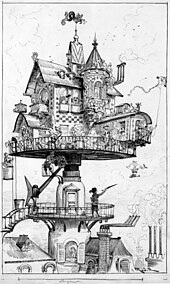
Back Steampunk Afrikaans Steampunk AN ستيم بانك Arabic Steampunk AST Stimpank Azerbaijani Стымпанк Byelorussian Steampunk Breton Steampunk Catalan ستیمپەنک CKB Steampunk Czech


Steampunk is a subgenre of science fiction that incorporates retrofuturistic technology and aesthetics inspired by, but not limited to, 19th-century industrial steam-powered machinery.[1][2][3] Steampunk works are often set in an alternative history of the Victorian era or the American frontier, where steam power remains in mainstream use, or in a fantasy world that similarly employs steam power.
Steampunk features anachronistic technologies or retrofuturistic inventions as people in the 19th century might have envisioned them — distinguishing it from Neo-Victorianism[4] — and is likewise rooted in the era's perspective on fashion, culture, architectural style, and art.[5] Such technologies may include fictional machines like those found in the works of H. G. Wells and Jules Verne.[6] Other examples of steampunk contain alternative-history-style presentations of such technology as steam cannons, lighter-than-air airships, analog computers, or such digital mechanical computers as Charles Babbage's Analytical Engine.[7][8]
Steampunk may also incorporate additional elements from the genres of fantasy, horror, historical fiction, alternate history, or other branches of speculative fiction, making it often a hybrid genre.[9] As a form of speculative fiction, it explores alternative futures or pasts but can also address real-world social issues.[10] The first known appearance of the term steampunk was in 1987, though it now retroactively refers to many works of fiction created as far back as the 1950s or earlier.[11] A popular subgenre is Japanese steampunk, consisting of steampunk-themed manga and anime.[12]
Steampunk also refers to any of the artistic styles, clothing fashions, or subcultures that have developed from the aesthetics of steampunk fiction, Victorian-era fiction, art nouveau design, and films from the mid-20th century.[13] Various modern utilitarian objects have been modded by individual artisans into a pseudo-Victorian mechanical "steampunk" style, and a number of visual and musical artists have been described as steampunk.[14]
- ^ "Definition of steampunk". Oxford University Press. Archived from the original on July 24, 2012. Retrieved 6 October 2012.
- ^ Latham, Rob (2014). The Oxford Handbook of Science Fiction. Oxford University Press. p. 439. ISBN 978-0-19-983884-4.
- ^ "What Is Steampunk All About? | Gear Gadgets and Gizmos". www.geargadgetsandgizmos.com/. 25 September 2017. Archived from the original on 24 March 2023. Retrieved Feb 23, 2020.
- ^ Nally, Claire (Nov 7, 2016). "EXPERT COMMENT: Steampunk, Neo-Victorianism, and the Fantastic" (Press release). Northumbria University, Newcastle's Newsroom. Archived from the original on March 21, 2023. Retrieved January 21, 2019.
- ^ STEAMPUNK. Lulu.com. 2014. Archived from the original on 2023-03-06. Retrieved 2021-02-23.
- ^ Campbell, Heather M. (Dec 1, 2010). "Steampunk: Full Steam Ahead". School Library Journal. 56 (12): 52–57. ISSN 0362-8930. Archived from the original on March 6, 2023. Retrieved April 24, 2019.
- ^ Cite error: The named reference
VanderMeerwas invoked but never defined (see the help page). - ^ Cite error: The named reference
Grossmanwas invoked but never defined (see the help page). - ^ Cite error: The named reference
Encyclopedia of Fantasywas invoked but never defined (see the help page). - ^ Taddeo, Julie Anne; Miller, Cynthia J. (2013). Steaming Into a Victorian Future: A Steampunk Anthology. Lanham, MD: Scarecrow Press. p. 5. ISBN 978-0-8108-8586-8.
- ^ "What Is Steampunk – Steam Punk Explained". steam-punk.co.uk. Archived from the original on March 6, 2023. Retrieved May 26, 2020.
- ^ Cite error: The named reference
Wiredwas invoked but never defined (see the help page). - ^ "Steampunk artists meld Victorian era, science fiction". Duluth News Tribune. January 1, 2012. Archived from the original on July 7, 2012. Retrieved March 6, 2012.
It's the stuff Jules Verne used to write about, looking at it from the hindsight of the 21st century,
- ^ "Steampunk's subculture revealed". SFGate. Archived from the original on August 18, 2017. Retrieved Aug 12, 2017.